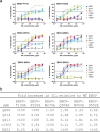Potent neutralizing monoclonal antibodies against Ebola virus infection
- PMID: 27181584
- PMCID: PMC4867612
- DOI: 10.1038/srep25856
Potent neutralizing monoclonal antibodies against Ebola virus infection
Abstract
Ebola virus infections cause a deadly hemorrhagic disease for which no vaccines or therapeutics has received regulatory approval. Here we show isolation of three (Q206, Q314 and Q411) neutralizing monoclonal antibodies (mAbs) against the surface glycoprotein (GP) of Ebola virus identified in West Africa in 2014 through sequential immunization of Chinese rhesus macaques and antigen-specific single B cell sorting. These mAbs demonstrated potent neutralizing activities against both pseudo and live Ebola virus independent of complement. Biochemical, single particle EM, and mutagenesis analysis suggested Q206 and Q411 recognized novel epitopes in the head while Q314 targeted the glycan cap in the GP1 subunit. Q206 and Q411 appeared to influence GP binding to its receptor NPC1. Treatment with these mAbs provided partial but significant protection against disease in a mouse model of Ebola virus infection. These novel mAbs could serve as promising candidates for prophylactic and therapeutic interventions against Ebola virus infection.
Conflict of interest statement
The authors declare no competing financial interests.
Figures






References
-
- Baize S. et al. Emergence of Zaire Ebola virus disease in Guinea. N Engl J Med 371, 1418–1425 (2014). - PubMed
-
- Barrette R. W. et al. Discovery of swine as a host for the Reston ebolavirus. Science 325, 204–206 (2009). - PubMed
-
- Leroy E. M. et al. Multiple Ebola virus transmission events and rapid decline of central African wildlife. Science 303, 387–390 (2004). - PubMed
-
- Walsh P. D. et al. Catastrophic ape decline in western equatorial Africa. Nature 422, 611–614 (2003). - PubMed
Publication types
MeSH terms
Substances
LinkOut - more resources
Full Text Sources
Other Literature Sources
Medical
Miscellaneous

